How Do 2 Types of Chatbots Work for Your Business
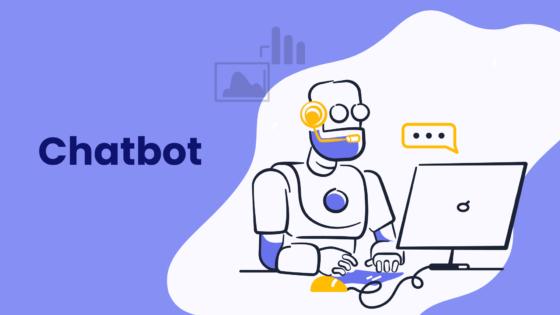
Businesses today rely on 2 types of chatbots: rule-based and AI-powered. Both play a major role in customer service, support, and ecommerce. Companies see strong results, with 67% of clients using chatbots for support and up to 90% of routine questions resolved by these tools. The chart below shows how modern businesses use chatbots across different sectors.
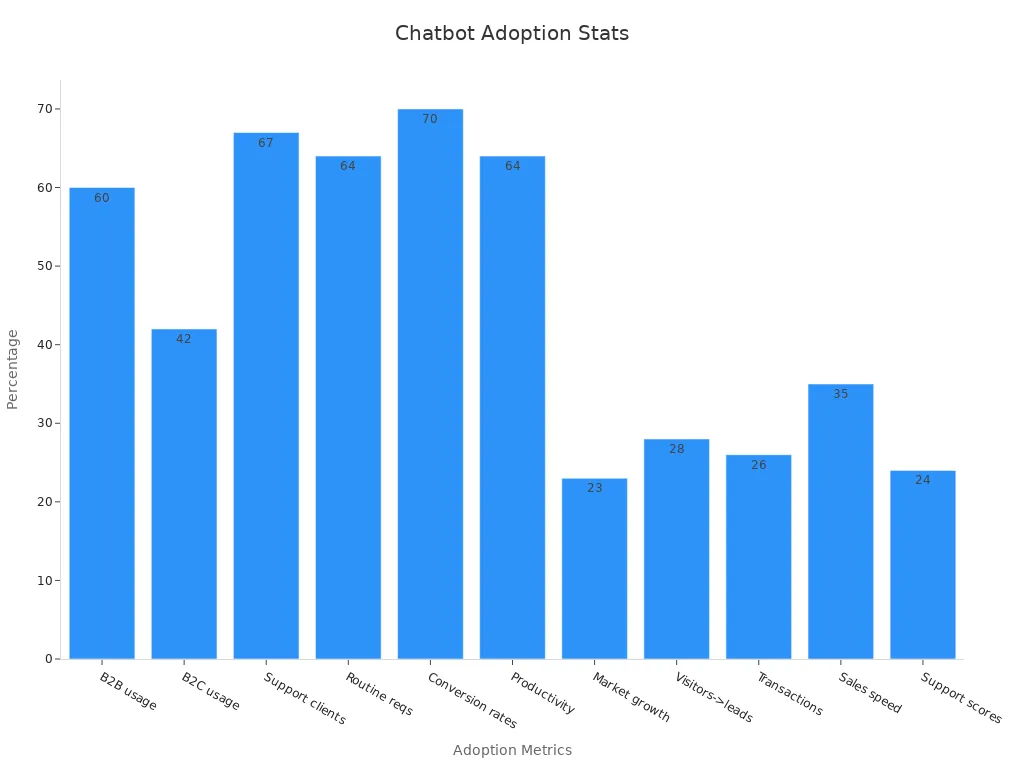
Sobot AI leads with advanced solutions, helping brands understand how do chatbots work and improve customer interactions using both 2 types of chatbots.
2 Types of Chatbots
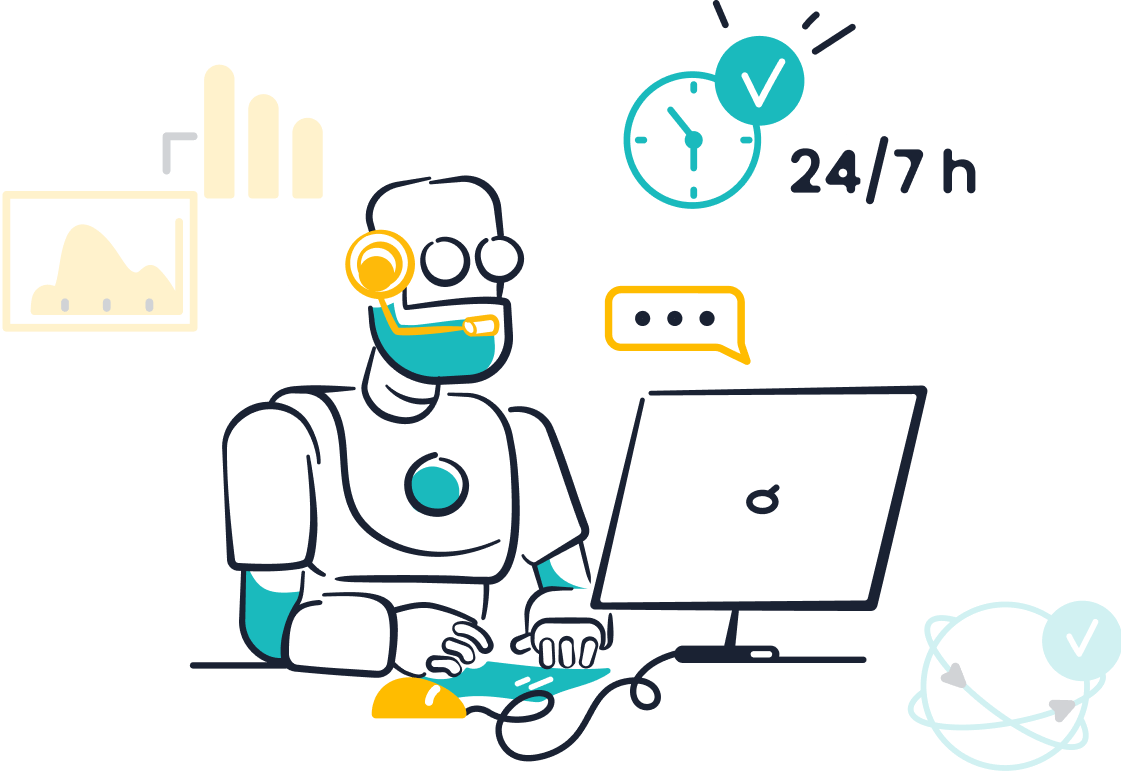
Rule-Based Chatbots
Rule-based chatbots follow a set of instructions to answer questions. This chatbot architecture uses decision trees or flowcharts. When a customer asks a question, the chatbot matches the input to a rule and gives a set response. These chatbots work best for simple, repetitive tasks. For example, they can answer FAQs, help with order tracking, or schedule appointments.
- Rule-based chatbots automate tasks like answering common questions and processing orders.
- They reduce query volume by up to 70% and provide answers three times faster than human agents.
- These chatbots enable customer self-service, which 81% of consumers prefer.
- Automating up to 80% of routine queries can lower support costs by about 30%.
Rule-based chatbots use a straightforward chatbot architecture. They help businesses save time and money by handling routine tasks. Sobot’s chatbot can use rule-based logic to deliver quick, consistent support across channels.
AI-Powered Chatbots
AI-powered chatbots use advanced technology to understand and respond to customers. This chatbot architecture relies on natural language processing (NLP) and machine learning. AI agents learn from past conversations and improve over time. They can handle complex questions and provide more human-like responses.
| Metric Description | Statistic / Result |
|---|---|
| Reduction in resolution time with AI tools | Up to 50% reduction |
| Improvement in first response time | 37% faster first responses |
| AI agents handling customer inquiries autonomously | 80% handled autonomously |
| Increase in repeat purchases due to AI automation | 36% increase |
| Positive customer feedback on AI service | Approximately 80% positive experiences |
Sobot’s AI chatbot uses this advanced chatbot architecture. It supports multiple languages, works across channels, and requires no coding. AI agents in Sobot’s system help businesses boost productivity and customer satisfaction.
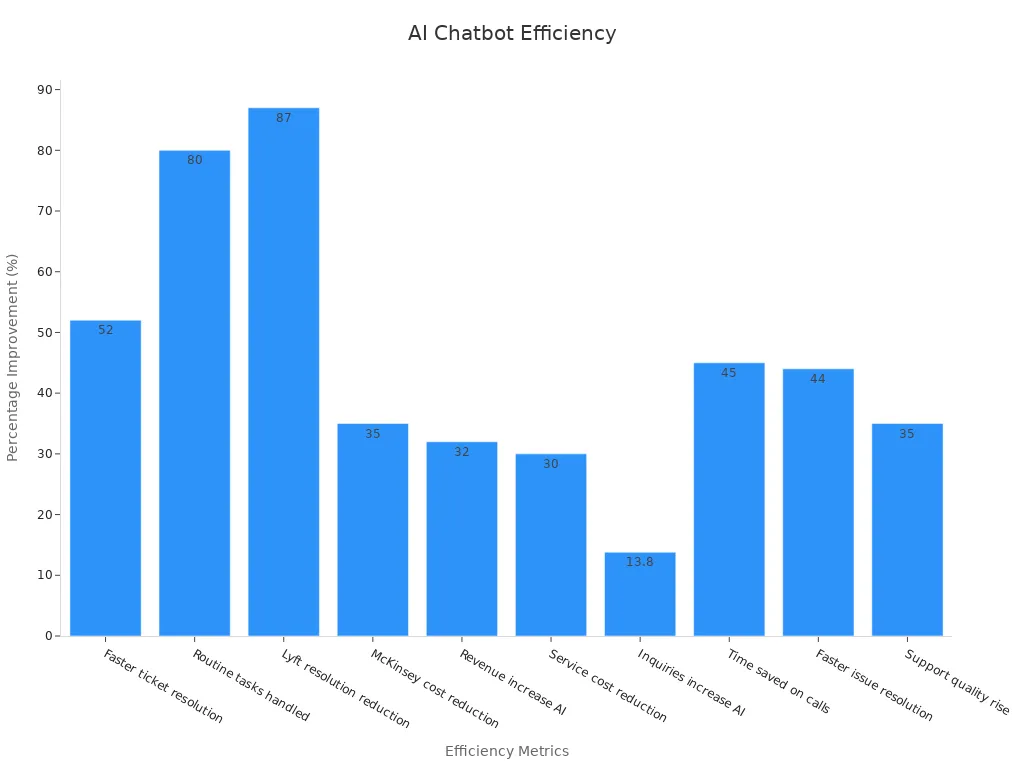
Key Differences
The 2 types of chatbots have different strengths. Rule-based chatbots follow strict rules and work well for simple tasks. AI-powered chatbots use AI agents and machine learning to handle more complex needs. The table below shows how they compare:
| Category | Rule-Based Chatbots | AI-Powered Chatbots |
|---|---|---|
| Performance | Good for repetitive tasks | Handles diverse, complex queries |
| Cost | Lower setup and maintenance | Higher initial cost, scalable for big needs |
| Implementation | Quick and easy | Takes longer, needs expertise |
| Scalability | Limited | Highly scalable |
| Flexibility | Rigid, less adaptable | Very flexible, learns and adapts |
| User Experience | Reliable for basics | More natural and engaging |
Sobot’s AI chatbot stands out by combining the best of both chatbot architectures. Businesses can choose the right solution based on their needs, whether they want simple automation or advanced AI agents for customer engagement.
Rule-Based Chatbots in Business
How They Work
Rule-based chatbots follow a set of pre-defined rules to guide customer interactions. These chatbots use decision trees or flowcharts to match user questions with specific answers. When a customer asks a question, the chatbot checks its rules and responds with the best answer. This process helps companies deliver fast and consistent customer service. Rule-based chatbot systems often automate repetitive tasks, such as answering FAQs or processing orders. Businesses can track important metrics like retention rate, fallback rate, customer satisfaction score (CSAT), and human takeover rate. These metrics help companies see how well their automated support works and where improvements are needed. For example, Klarna’s virtual assistant managed two-thirds of customer chats and reduced average resolution time from 11 to under 2 minutes, showing how do chatbots work to boost efficiency and satisfaction.
Use Cases
Rule-based chatbots serve many industries. In retail and e-commerce, they help with order tracking, product questions, and returns. These chatbots can increase conversion rates, reduce cart abandonment, and provide 24/7 support. For example, Jumia’s chatbot achieved a 70% containment rate and a 76% CSAT lift. In enterprise services, rule-based chatbot systems deflect common tech queries and speed up onboarding. Healthcare uses them for appointment scheduling and patient reminders. Financial services automate inquiries and improve onboarding efficiency. The table below shows key ROI drivers and performance metrics across sectors:
| Industry | Key ROI Drivers | Performance Metrics |
|---|---|---|
| Retail/E-commerce | Conversion, upselling, 24/7 support | 70% containment, 76% CSAT |
| SaaS/Tech Support | Faster resolution, onboarding | 210% ROI, $2.1M savings |
| Healthcare | Scheduling, triage, reminders | Cost savings, engagement |
| Financial Services | Inquiry automation, fraud detection | 62.5% efficiency gain |
Sobot Chatbot Features
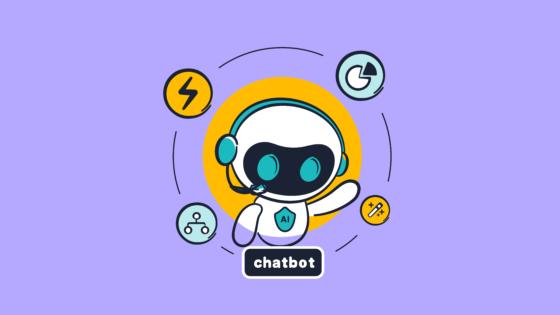
Sobot’s chatbot integrates rule-based logic to deliver structured customer interactions. The system can resolve up to 80% of routine inquiries within seconds, which boosts customer satisfaction by 34% and reduces support costs by up to 30%. Sobot’s platform supports omnichannel communication, so customers can reach support through chat, email, or social media. The chatbot is easy to set up with a point-and-click interface, making automated support accessible for any business. Sobot also allows companies to personalize customer interactions, which helps brands see up to 41% higher conversion rates. By combining rule-based chatbot workflows with AI-driven features, Sobot ensures efficient, reliable, and scalable customer service.
AI-Based Chatbots for Customer Contact
How AI Chatbot Works
AI chatbot systems use advanced technology to create human-like conversations. These chatbots rely on natural language processing (NLP) and machine learning. The nlp chatbot can understand different languages, detect user intent, and respond with natural language generation. AI agents analyze messages, learn from past customer interactions, and improve over time. This chatbot architecture allows for flexible, contextual understanding and adapts to new questions. AI agents use deep learning models to recognize patterns and provide accurate answers. The nlp chatbot can switch between topics, remember details, and offer real-time support. With conversational ai, businesses can deliver seamless customer experience across channels.
Business Benefits
AI-based chatbots bring many advantages to businesses. They handle customer interactions 24/7 and reduce wait times. AI agents can answer complex questions, guide users, and boost satisfaction. The nlp chatbot supports multiple languages, making it easy to serve global customers. Companies see higher conversion rates and lower costs. According to industry research, 83% of organizations report positive ROI from artificial intelligence chatbots. Over 80% of consumers have positive experiences with ai chatbot tools. The nlp chatbot also improves productivity by automating routine tasks. Businesses in banking, retail, and e-commerce use ai agents to increase sales and enhance customer experience.
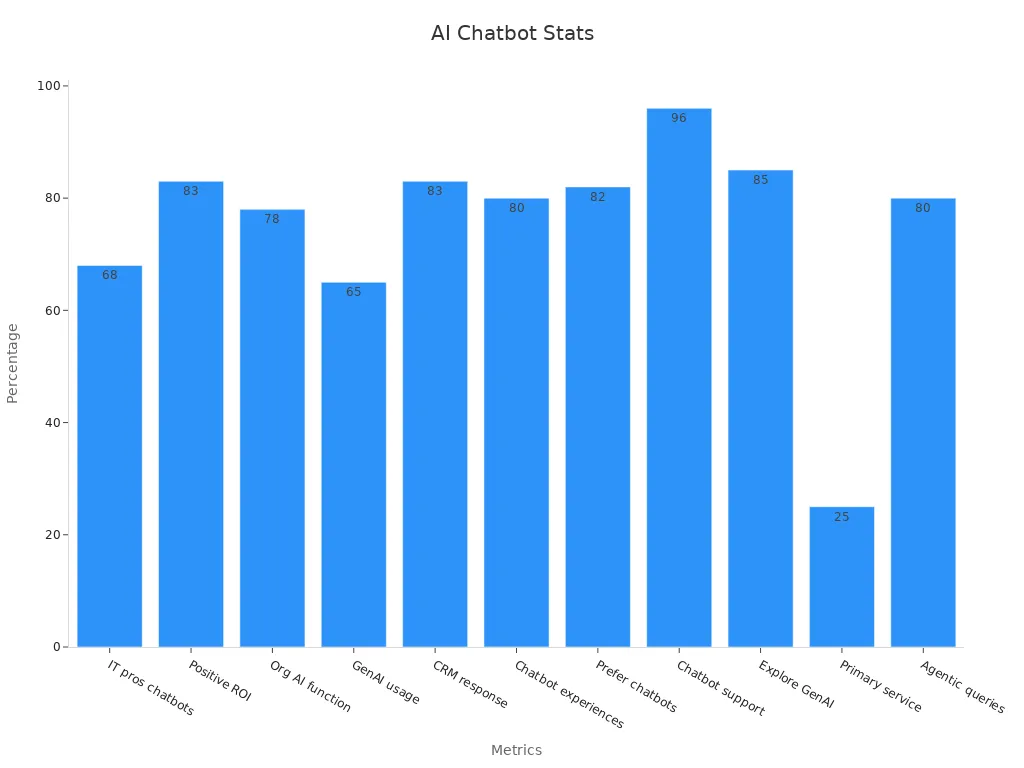
Note: AI-powered chatbots rely on diverse multilingual data and continuous training to process queries in many languages. This ensures accurate responses and better engagement worldwide.
Sobot AI Chatbot Example
Sobot’s ai chatbot stands out with its multilingual, omnichannel, and no-code features. Businesses can deploy the nlp chatbot across chat, email, voice, and social media. AI agents in Sobot’s system use advanced chatbot architecture to deliver human-like conversations and smart self-service. The platform supports natural language generation and adapts to user intent. Sobot’s ai agents help companies like OPPO manage high volumes of customer interactions. OPPO improved its chatbot resolution rate to 83% and saw a 94% positive feedback rate. The ai chatbot reduced manual work and increased repurchase rates by 57%. Sobot’s solution shows how artificial intelligence chatbots can transform customer experience and drive business growth.
Rule-Based vs. AI-Powered Chatbots
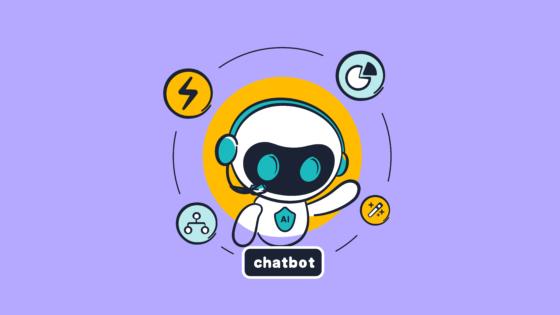
Comparison Table
Business leaders often compare rule-based chatbots and AI-powered chatbots to decide which fits their needs. The table below shows how each type performs across important factors:
| Aspect | Rule-Based Chatbots | AI-Powered Chatbots |
|---|---|---|
| Use Case Suitability | Best for simple, predictable tasks like FAQs, fixed-menu guidance, appointment booking | Ideal for dynamic, complex interactions such as varied customer support, lead qualification, product recommendations |
| Flexibility | Limited flexibility; rigid scripts and decision trees; manual updates required | Highly flexible; understands context and intent; adapts dynamically; continuous learning |
| Scalability | Scaling requires manual programming; costly and cumbersome for complex queries | Inherently scalable; easy integration with CRM, ERP, and other platforms; handles broad queries |
| User Experience | Can feel robotic and constrained; limited vocabulary leads to dead ends | Provides natural, human-like conversations; handles multi-turn dialogues and personalized suggestions |
| Maintenance & Upkeep | Requires significant manual upkeep to remain relevant | Learns and improves over time, reducing maintenance overhead |
| Business Impact | Risk of losing leads due to inflexible dialogue paths | Drives higher conversion rates; reduces support workload; enables 24/7 quality service |
| Industry Adoption | Suitable for very specific, controlled scenarios | Widely adopted in retail, finance, healthcare for personalized, real-time customer engagement |
Businesses also use quantitative metrics to measure chatbot performance. These include response relevance, intent prediction accuracy, escalation rates, and user engagement. The table below lists some key metrics:
| Quantitative Factor | Description | Typical Range / Notes |
|---|---|---|
| Response Generation Time | Time taken to generate a response | 0.1–2 seconds |
| Intent Prediction Accuracy | Correctly identifying user intents | 70–95% |
| Escalation Rates | How often the chatbot hands off to a human agent | 5–30% |
| User Ratings (Thumbs Up/Down) | Simple feedback on chatbot responses | 0 (worst) to 1 (best) |
| Dialogue Helpfulness | How helpful the chatbot is in progressing the conversation | User feedback or analysis |
Note: Sobot’s AI-powered chatbots use advanced metrics and reporting to help businesses track and improve these factors, ensuring high-quality customer experiences.
Strengths and Limitations
Both rule-based and AI-powered chatbots have unique strengths and limitations. Rule-based chatbots excel at handling routine, predictable tasks. They provide fast answers for FAQs, order tracking, and appointment scheduling. These bots work well when customers ask questions that match pre-set rules. However, they struggle with unexpected queries or complex conversations. Manual updates are needed to keep them relevant.
AI-powered chatbots, powered by ai agents, offer much greater flexibility. They use natural language processing and machine learning to understand context and intent. Ai agents can handle multi-turn conversations, adapt to new topics, and personalize responses. This leads to a more natural and engaging user experience. Ai agents also reduce the need for manual updates, as they learn from each interaction. Businesses using ai agents see higher conversion rates and improved customer satisfaction.
The chart below shows the number of pros and cons for each chatbot type:
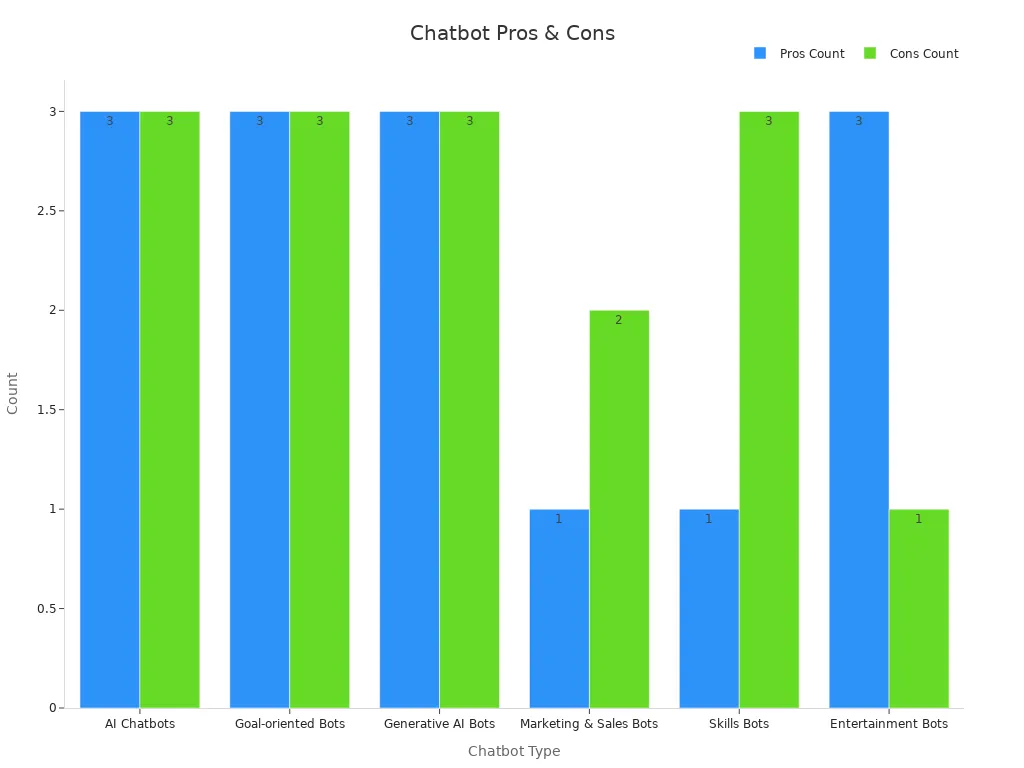
Tip: Sobot’s ai agents combine the best of both worlds. They automate routine tasks and handle complex queries, making them a strong choice for businesses seeking efficiency and growth.
Best Fit Scenarios
Choosing the right chatbot depends on your business needs and industry. Rule-based chatbots fit best in situations with clear, repetitive tasks. For example, retail stores use them for product discovery and order status updates. Financial services rely on them for routine transactions and appointment scheduling. These bots require less investment and are easy to set up.
Ai agents shine in industries that need personalized, dynamic support. Healthcare providers use ai agents for patient screening and appointment reminders. E-commerce companies deploy ai agents for product recommendations and customer support. Ai agents also help financial advisors deliver tailored advice. These chatbots handle complex, multi-turn conversations and adapt to changing customer needs.
| Aspect / Criteria | Rule-Based Chatbots | AI-Powered Chatbots |
|---|---|---|
| Best-fit Applications | Standardized, predictable inquiries: appointment scheduling, FAQs, basic orders | Complex, multi-turn conversations requiring context, personalization, adaptability |
| Industry Examples | Retail (product discovery, order status), Financial Services (routine transactions) | Healthcare (patient screening), Financial advisory, E-commerce (personalized recommendations) |
| Investment & Cost | Lower initial investment, straightforward development and maintenance | Higher upfront cost, ongoing training and optimization |
| Precision & Handling | High accuracy for anticipated queries, fallback on unknown inputs | Handles unexpected queries, understands context, reduces customer frustration by up to 40% |
| Scalability | Limited scalability, manual rule expansion, language support requires separate bots | Scalable via transfer learning, easier multi-language support, organic complexity growth |
| Personalization | Limited to basic info insertion (e.g., name) | Advanced personalization using conversation history, purchase patterns, sentiment detection |
| Integration | Simple API integration with basic systems | Robust integration with multiple business platforms, complex data analysis and recommendations |
Sobot’s ai agents support both rule-based and AI-powered workflows. For example, Sobot helped OPPO manage high volumes of customer inquiries by combining ai agents with a robust knowledge base. This approach led to an 83% chatbot resolution rate and a 94% positive feedback rate. Sobot’s ai agents also support omnichannel communication, making them ideal for businesses that want to unify sales, marketing, and support.
Businesses should consider the complexity of their customer interactions, the need for personalization, and their growth plans when choosing between rule-based chatbots and ai agents. Sobot’s solutions offer flexibility, scalability, and advanced ai agents to meet diverse business needs.
Choosing the Right Chatbot
Decision Factors
Selecting the right chatbot for a business involves careful analysis. Many companies use a multi-criteria decision-making framework, such as the Analytic Hierarchy Process (AHP) combined with the Combined Compromise Solution (CoCoSo) method. This approach helps leaders weigh factors like cost, scalability, integration, and customer experience. Businesses often compare rule-based chatbots and ai agents using statistical benchmarks. For example, ai agents can improve over time by learning from user data, while rule-based bots follow fixed scripts. Companies also look at process mining metrics to see how well chatbots follow business workflows. These metrics include response time, intent recognition, and automation rates. The table below shows key decision factors:
| Decision Factor | Rule-Based Chatbots | AI-Powered Chatbots (ai agents) |
|---|---|---|
| Upfront Costs | Lower | Higher, but lower long-term costs |
| Scalability | Limited | Easily handles spikes |
| Availability | Business hours | 24/7 support |
| Personalization | Basic | Advanced, delivers personalized experience |
| Analytics | Limited | Automatic, real-time insights |
Sobot Solution Overview
Sobot offers an all-in-one contact center platform that supports both rule-based and AI-powered chatbots. The platform uses ai agents to deliver fast, accurate, and scalable support. Sobot’s chatbots achieve high resolution rates and maintain response times under two seconds. The system tracks over 300 statistical reports, including first contact resolution, escalation rates, and customer sentiment scores. Ai agents in Sobot’s solution provide seamless integration with CRM and e-commerce systems. They also support over 20 languages, ensuring a consistent customer experience worldwide. Sobot’s chatbots help businesses boost conversion rates and improve self-service success. The platform’s analytics give leaders the data needed to optimize every interaction.
Tip: Sobot’s ai agents combine automation with human-like understanding, making them ideal for businesses that want to enhance customer experience and efficiency.
Getting Started
Businesses can start with Sobot by reviewing key performance indicators across customer contact, reception, and management. Sobot’s platform provides extensive reporting and quality inspection tools. Ai agents guide users through setup with a no-code interface, making deployment simple. Companies can monitor chatbot performance using real-time dashboards and adjust workflows as needed. Sobot’s support team offers training and resources to help businesses maximize value. To learn more about Sobot’s solutions or request a demo, visit Sobot’s official website or contact their team at marketing@sobot.io.
Businesses see clear differences between rule-based and AI-powered chatbots. Rule-based bots handle simple tasks, while AI-powered bots manage complex conversations and improve over time. Sobot’s solutions help companies boost efficiency, increase sales, and deliver a better customer experience. The table below highlights key metrics that show chatbot effectiveness:
| Metric | Business Impact |
|---|---|
| First-Contact Resolution Rate | Faster problem solving, higher satisfaction |
| Cost Savings | Lower expenses, improved resource use |
| User Satisfaction Score | Better customer experience, loyalty, and retention |
Sobot’s platform supports growth and helps teams achieve strong results. To learn more, visit Sobot’s website or contact their team for a demo.
FAQ
What is the main difference between a rule-based chatbot and an AI-powered chatbot?
A rule-based chatbot follows set rules and scripts. An AI-powered chatbot uses machine learning and NLP to understand and respond. AI agents can handle complex questions, while rule-based chatbots work best for simple, repetitive tasks.
How do chatbots improve customer service for businesses?
Chatbots provide instant answers 24/7. They reduce wait times and handle up to 80% of routine queries. Sobot’s AI agents help companies like OPPO achieve an 83% chatbot resolution rate and a 94% positive feedback rate.
Can Sobot’s chatbot support multiple languages and channels?
Yes! Sobot’s chatbot supports over 20 languages and works across chat, email, voice, and social media. This omnichannel approach helps businesses reach more customers and deliver consistent support worldwide.
What are some real-world results from using Sobot’s AI agents?
OPPO used Sobot’s AI agents to manage high volumes of customer inquiries. The company saw a 57% increase in repurchase rates and reduced manual work by 90%. These results show how AI-powered chatbots drive business growth.
How can a business choose the right chatbot for its needs?
Tip: Businesses should consider task complexity, customer expectations, and growth plans. Rule-based chatbots suit simple tasks. AI agents fit dynamic, personalized support. Sobot’s platform offers both options for flexible, scalable solutions.
See Also
How To Select The Top Chatbot Software Solutions
Ways Chatbots Enhance Customer Experience In E-commerce
Steps To Build A Chatbot That Drives Website Success
